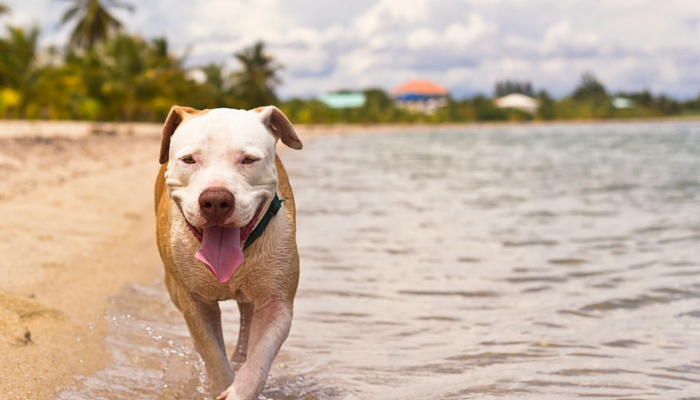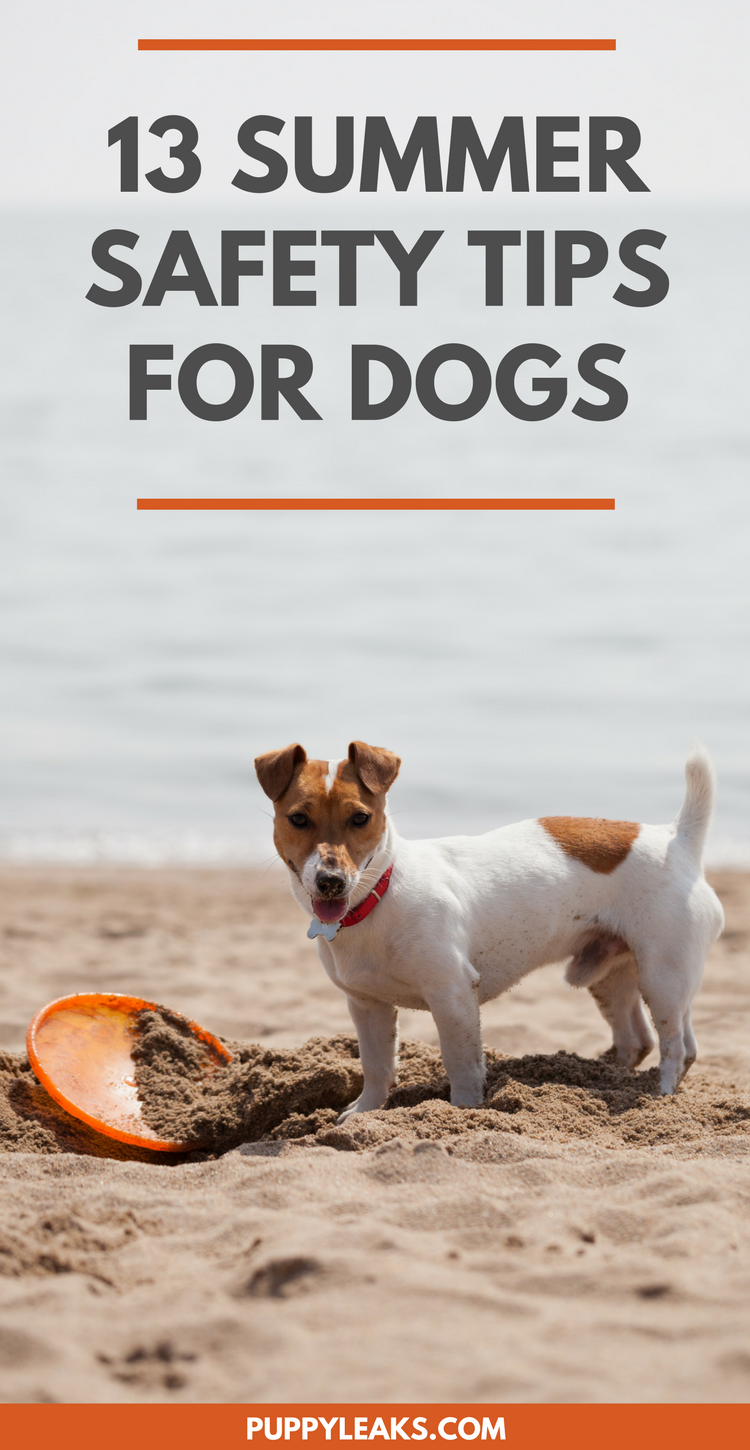Your cart is currently empty!

13 Summer Safety Tips for Dogs
13 Summer Safety Tips for Dogs
Summer is officially here, so I thought it would be a good idea to do a quick recap on how to keep your dog safe in the summer.
And let’s clear one thing up real quick; you can give your dog ice cubes. Despite that viral post warning against it, vets agree that it’s completely acceptable to give your dog some ice. My dog loves playing with ice cubes, and in the summer it’s an easy way to help keep her cool.
13 Summer Safety Tips For Dogs
Summer is a great time to go out and have fun with your dog, but there are a few things to watch out for. Keep these 13 summer safety tips for dogs in mind to help keep your dog safe.
1. Give Your Dog Plenty of Water & Shade
If you’re going to be outside for long periods of time with your dog this summer make sure they have a nice shady spot to rest in and plenty of water.
Dog’s can’t regulate heat as well as us, so it’s not as easy for them to stay cool. Prolonged heat exposure puts them at risk for developing heat stroke.
Too much heat and humidity can be hazardous to your dogs health, so if you’re not comfortable outside because it’s too hot it’s also too hot for your dog. On those really hot days it’s safer to keep your dog entertained inside.
2. Use a Kiddie Pool or Sprinkler to Keep Cool
Does your dog love the water? Fill up a kiddie pool with water for your pup to cool off in. I suggest picking up a plastic one, since their nails can tear the softer ones. Don’t have a kiddie pool? Plenty of dogs enjoy playing with the hose or sprinklers.
3. Avoid Prolonged Exposure to Hot Sand & Pavement
Avoid prolonged exposure to sand and hot asphalt – it can burn your dogs paws. In the summer try to walk your dog in the morning or evening when the pavement isn’t so hot. If you walk during the day stick to grassy or wooded areas.
If you are going to go out for a long walk try some Musher’s Secret to keep their paws protected. And for extremely hot days you can get a pair of boots for your dog.
Check the pavement for heat before taking your dog on a walk. Place your hand or a bare foot on the surface for 10 seconds. If it is too hot for you to keep your hand or foot on it, then it is too hot for your pet. – Banfield Pet Hospital
4. Short Faced Dogs Are More Susceptible to Heat Stroke
If you have a short faced dog like a Bulldog or Pug remember that they don’t pant efficiently; they’re much more susceptible to heat stroke. Bulldogs are especially intolerant to heat. They should have limited access to the outdoors when the weather gets above 80 degrees.
5. Don’t Leave Your Dog Alone in a Hot Car
Never leave your dog inside your car in hot weather; a cracked window isn’t enough to keep a car cool. It’s also illegal in many states.
Researchers learned that when it’s a sunny 78 degrees, the temperature in a parked car with windows cracked rises at least 32 degrees in 30 minutes. So: 78 degrees to 110 in half an hour. – Don’t Think For a Minute Dogs Can Survive in a Hot Car
6. Avoid Strenuous Exercise
Avoid strenuous exercise during extremely hot days & keep the sessions short. The same goes for days with high humidity. For those really hot days check out some simple activities to keep your dog busy indoors.
7. Watch Out For Doggie Sunburn
Dogs can get sunburn – especially light colored dogs with short fur. There are sun protection lotions specifically formulated for dogs. Don’t use human sunscreen on your pet; many of the chemicals are toxic to them.
All canines, regardless of the thickness of their coats, have vulnerable areas of the body with less fur or none at all. The belly is often covered with blonde hair, making it a target; the ears have delicate skin; and even a dog’s nose can become dried out and baked.- Pet360
8. Make Sure Your Pet is Protected from Pests
Ticks and mosquitoes are at their peak in the summer. Talk to your vet about the different preventatives available. Do a thorough skin check (the same one you’d do for fleas) on your dog after coming inside to look for ticks.
9. Watch Your Dog Around Treated Lawns
Keep dogs off lawns that have been chemically treated with fertilizer for at least 24 hours. Many of the chemicals used in lawn treatments are toxic to pets.
While small ingestions of fertilizer may only result in mild stomach upset, larger ingestions can result in severe poisoning from the iron, nitrogen and other chemicals. – Pet Poison Hotline
10. Don’t Let Dogs Drink From Oceans, Lakes or Pools
Don’t let your dog drink seawater; it causes dehydration and vomiting. If a dog ingests enough it can be fatal. Bring fresh water for your dog when you’re going out to the beach.
11. Shaving Your Dog Might Not Keep Him Cool
Do not shave your dog because he’s panting. If you have a double coated breed their fur is actually providing relief from the heat, and shaving it will make it worse.
12. Keep Your Pet Inside During the 4th of July
Most dogs are terrified of fireworks. Shelters experience 30% more dogs coming in on July 5th than any other day of the year. Keep him indoors on the 4th of July.
If your dog has noise phobias work on some desensitization and counter conditioning before the 4th. For extremely anxious dogs you can consult with your veterinarian to find out if anxiety medication might help.
13. Make Sure Your Dog is Wearing Identification
We spend a lot of time outdoors with our dogs in the summer, and that increases the risk of them running off or getting lost. Make sure your dog has a collar with your phone number on it, and it’s a good idea to have your dog microchipped in case their collar comes off.
One of the best ways to prevent your dog from getting lost is to keep them on a leash in areas that aren’t fenced. (keep in mind some dogs can easily jump a 6 foot fence)
The Signs of Heat Stroke
No matter what activities you and your best friend will be enjoying this summer make sure you know the signs of heatstroke. It’s considered a medical emergency and needs to be handled immediately:
Early Stages of Heat Stroke:
- Heavy panting
- Excessive drooling
- Balance problems
- Bright red gums
Advanced Stages of Heat Stroke
- Labored & noisy breathing
- White gums
- Lethargy
- Vomiting
If you suspect your dog may be suffering from heat stroke measures must be taken immediately to cool him down. Take your dog inside immediately. If you have a thermometer take his temperature – if it’s above 104F you need to begin cooling him down.
Start by spraying or immersing him in cool water. Drape your dog with cool towels. Don’t use ice water if your dog has heat stroke – it will close the dogs pores and make the problem worse. You need to gradually decrease his temperature without inducing shock. Take your dog to the veterinarian as soon as possible following an episode of heat stroke as it can be associated with other complications.
Enjoy the Warm Weather Safety With Your Dog
If you’re looking to go out with your dog this summer keep these tips in mind. You can enjoy the summer with your dog safely with a few simple tips.
This post contains affiliate links; if you make a purchase I’ll earn a small commission.

Leave a Reply